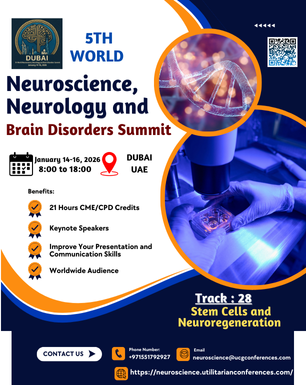



Sub Topics: Molecular and Cellular Neuroscience, Cognitive Neuroscience,...

Sub Tracks Clinical Neurology, Neurodegenerative...

SUBTOPIC; Stem Cells: Basics and Types,
Neuroregeneration and its Challenges, Mechanisms of Stem Cell-Mediated
Neuroregeneration, Applications of Stem Cells in Neuroregeneration, Clinical
Challenges and Future Directions
Stem Cells and Neuroregeneration
Stem cells and neuroregeneration are
pivotal concepts in modern neuroscience and regenerative medicine, holding the
promise to repair, restore, or even regenerate damaged tissues in the nervous
system. Stem cell therapies are increasingly being explored as potential
treatments for neurodegenerative diseases, brain injuries, and spinal cord
injuries. The ability to harness stem cells to promote regeneration of neurons and
restore brain and spinal cord functions is a rapidly evolving field with
profound implications for treating conditions that currently have limited
therapeutic options.Stem Cells:
Embryonic Stem
Cells (ESCs):
Source: Derived from the inner cell mass of a
blastocyst (early-stage embryo).
Potency: Pluripotent—can differentiate into any
cell type in the body, including neurons.
Use in
Neuroregeneration: ESCs are
ideal for studying neurodevelopment and have potential in treating
neurodegenerative diseases, though ethical concerns surrounding their use
exist.
Induced
Pluripotent Stem Cells (iPSCs):
Source: Adult somatic cells (e.g., skin or blood
cells) reprogrammed to a pluripotent state using specific genes.
Potency: Pluripotent—like ESCs, iPSCs can
differentiate into various cell types, including neurons.
Use in
Neuroregeneration: iPSCs
can be patient-specific, reducing immune rejection risks. They hold potential
for personalized treatments in neurodegenerative diseases like Parkinson’s and
Alzheimer’s.
Adult Stem
Cells:
Source: Found in various tissues such as the
brain, bone marrow, and skeletal muscle.
Potency: Multipotent—can differentiate into a
limited range of cell types related to their tissue of origin (e.g., neural
stem cells in the brain).
Use in
Neuroregeneration: Adult
neural stem cells (NSCs) in the brain can give rise to neurons, glial cells,
and oligodendrocytes, which are critical for repairing and regenerating damaged
neural tissue.
Mesenchymal
Stem Cells (MSCs):
Source: Typically isolated from bone marrow,
adipose tissue, or umbilical cord.
Potency: Multipotent—can differentiate into various
cell types, such as osteocytes, chondrocytes, and adipocytes, and have shown
some ability to differentiate into neural-like cells.
Use in
Neuroregeneration: MSCs
have been studied for their potential to promote repair and reduce inflammation
in the central nervous system (CNS).
2.
Neuroregeneration and its Challenges
Neuroregeneration refers to the process of repairing or
replacing damaged neurons in the central and peripheral nervous systems. Unlike
other tissues, the nervous system has a limited ability to regenerate after
injury, making neurodegenerative diseases and brain injuries particularly
challenging to treat.
Challenges in
Neuroregeneration:
Limited
Natural Regeneration in the CNS:
In the brain and
spinal cord, neuronal regeneration is limited. After injury, neurons often fail
to regenerate because of the lack of supportive environments and the presence
of inhibitory signals.
The blood-brain barrier also complicates the delivery of stem
cells and regenerative therapies to the brain.
Scar Formation
and Inhibitory Environment:
After injury, glial
cells (such as astrocytes) form a glial scar, which impedes the regrowth of
axons and prevents regeneration in the CNS.
In contrast to
peripheral nerves, which can regenerate if the injury is properly managed, the
CNS remains less adaptable to injury.
Cellular and
Molecular Barriers:
Differentiation of
stem cells into functional neurons and their integration into existing neural
circuits remains a major hurdle.
Proper signaling
pathways, growth factors, and interactions with surrounding tissues are crucial
for successful neurogenesis.
3. Mechanisms
of Stem Cell-Mediated Neuroregeneration
Stem cells offer
the possibility of replacing lost or damaged neurons and promoting the
regeneration of injured tissues in the nervous system. The primary mechanisms
through which stem cells can promote neuroregeneration include:
1. Direct
Differentiation into Neurons and Glial Cells:
Stem cells can
differentiate into various types of neurons (dopaminergic, motor neurons,
sensory neurons) and glial cells (astrocytes, oligodendrocytes) that are
essential for proper brain function.
This process is
guided by specific signaling molecules, growth factors, and environmental cues.
For example:
Brain-derived
neurotrophic factor (BDNF) and glial-derived neurotrophic factor (GDNF) support the survival and
differentiation of neurons.
Sonic hedgehog
(Shh) and Notch signaling pathways regulate neural stem cell
differentiation and proliferation.
2. Promotion
of Endogenous Repair:
Stem cells,
especially those derived from the brain (neural stem cells), can stimulate the
surrounding resident cells, including glial cells, to support regeneration.
They release growth
factors and cytokines that promote neuroprotection, reduce inflammation, and
enhance neuronal survival in the injured tissue.
For instance, mesenchymal stem cells (MSCs) have been shown to secrete molecules
that modulate immune responses and promote tissue repair in animal models of
brain injury.
3. Paracrine
Effects (Secretion of Growth Factors and Cytokines):
Even without direct
differentiation into neurons, stem cells can have therapeutic effects by
secreting beneficial factors that influence the surrounding environment.
4. Synaptic
Integration and Circuit Formation:
Successful
neuroregeneration involves not only the production of new neurons but also
their integration into existing neural circuits. This is particularly
challenging in complex brain regions.
Studies in animal
models have shown that stem cells, once differentiated into neurons, can form
functional synapses and potentially restore lost functions.